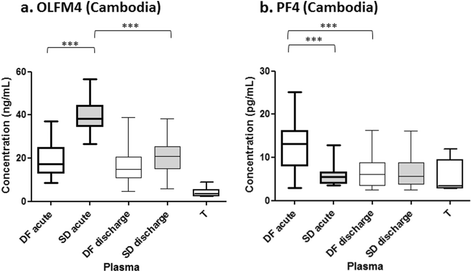Differential proteomic analysis of virus-enriched fractions obtained from plasma pools of patients with dengue fever or severe dengue
- PMID: 26572220
- PMCID: PMC4647599
- DOI: 10.1186/s12879-015-1271-7
Differential proteomic analysis of virus-enriched fractions obtained from plasma pools of patients with dengue fever or severe dengue
Abstract
Background: Dengue is the most widespread mosquito-borne viral disease of public health concern. In some patients, endothelial cell and platelet dysfunction lead to life-threatening hemorrhagic dengue fever or dengue shock syndrome. Prognostication of disease severity is urgently required to improve patient management. The pathogenesis of severe dengue has not been fully elucidated, and the role of host proteins associated with viral particles has received little exploration.
Methods: The proteomes of virion-enriched fractions purified from plasma pools of patients with dengue fever or severe dengue were compared. Virions were purified by ultracentrifugation combined with a water-insoluble polyelectrolyte-based technique. Following in-gel hydrolysis, peptides were analyzed by nano-liquid chromatography coupled to ion trap mass spectrometry and identified using data libraries.
Results: Both dengue fever and severe dengue viral-enriched fractions contained identifiable viral envelope proteins and host cellular proteins. Canonical pathway analysis revealed the identified host proteins are mainly involved in the coagulation cascade, complement pathway or acute phase response signaling pathway. Some host proteins were over- or under-represented in plasma from patients with severe dengue compared to patients with dengue fever. ELISAs were used to validate differential expression of a selection of identified host proteins in individual plasma samples of patients with dengue fever compared to patients with severe dengue. Among 22 host proteins tested, two could differentiate between dengue fever and severe dengue in two independent cohorts (olfactomedin-4: area under the curve (AUC), 0.958; and platelet factor-4: AUC, 0.836).
Conclusion: A novel technique of virion-enrichment from plasma has allowed to identify two host proteins that have prognostic value for classifying patients with acute dengue who are more likely to develop a severe dengue. The impact of these host proteins on pathogenicity and disease outcome are discussed.
Figures




Similar articles
-
Differential Proteomic Profiling at Different Phases of Dengue Infection: An Intricate Insight from Proteins to Pathogenesis.J Proteome Res. 2024 Sep 6;23(9):3731-3745. doi: 10.1021/acs.jproteome.3c00751. Epub 2024 Aug 12. J Proteome Res. 2024. PMID: 39132695
-
Early Detection of Plasma Leakage in Dengue Hemorrhagic Fever.Acta Med Indones. 2018 Jul;50(3):183-184. Acta Med Indones. 2018. PMID: 30333266
-
Molecular classification of outcomes from dengue virus -3 infections.J Clin Virol. 2015 Mar;64:97-106. doi: 10.1016/j.jcv.2015.01.011. Epub 2015 Jan 17. J Clin Virol. 2015. PMID: 25728087 Free PMC article.
-
Host Genetic Polymorphisms Influencing Susceptibility to Dengue.DNA Cell Biol. 2018 Oct;37(10):805-807. doi: 10.1089/dna.2018.4372. Epub 2018 Aug 16. DNA Cell Biol. 2018. PMID: 30113225 Review.
-
Plasma leakage in dengue haemorrhagic fever.Thromb Haemost. 2009 Dec;102(6):1042-9. doi: 10.1160/TH09-03-0208. Thromb Haemost. 2009. PMID: 19967133 Free PMC article. Review.
Cited by
-
Risk predictors of progression to severe disease during the febrile phase of dengue: a systematic review and meta-analysis.Lancet Infect Dis. 2021 Jul;21(7):1014-1026. doi: 10.1016/S1473-3099(20)30601-0. Epub 2021 Feb 25. Lancet Infect Dis. 2021. PMID: 33640077 Free PMC article.
-
Drug repositioning for dengue haemorrhagic fever by integrating multiple omics analyses.Sci Rep. 2019 Jan 24;9(1):523. doi: 10.1038/s41598-018-36636-1. Sci Rep. 2019. PMID: 30679503 Free PMC article.
-
Proteomics Analysis of Peripheral Blood Mononuclear Cells from Patients in Early Dengue Infection Reveals Potential Markers of Subsequent Fluid Leakage.Viruses. 2025 May 31;17(6):805. doi: 10.3390/v17060805. Viruses. 2025. PMID: 40573396 Free PMC article.
-
Role of Platelet Cytokines in Dengue Virus Infection.Front Cell Infect Microbiol. 2020 Sep 30;10:561366. doi: 10.3389/fcimb.2020.561366. eCollection 2020. Front Cell Infect Microbiol. 2020. PMID: 33102253 Free PMC article. Review.
-
7D, a small molecule inhibits dengue infection by increasing interferons and neutralizing-antibodies via CXCL4:CXCR3:p38:IRF3 and Sirt1:STAT3 axes respectively.EMBO Mol Med. 2024 Oct;16(10):2376-2401. doi: 10.1038/s44321-024-00137-8. Epub 2024 Sep 16. EMBO Mol Med. 2024. PMID: 39284947 Free PMC article.
References
-
- World Health Organization . Dengue: Guidelines for Diagnosis, Treatment, Prevention and Control: New Edition. Geneva: World Health Organization; 2009. - PubMed
-
- Falconar AK. The dengue virus nonstructural-1 protein (NS1) generates antibodies to common epitopes on human blood clotting, integrin/adhesin proteins and binds to human endothelial cells: potential implications in haemorrhagic fever pathogenesis. Arch Virol. 1997;142:897–916. doi: 10.1007/s007050050127. - DOI - PubMed
Publication types
MeSH terms
Substances
LinkOut - more resources
Full Text Sources
Other Literature Sources
Medical
Miscellaneous

